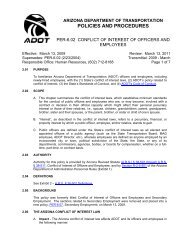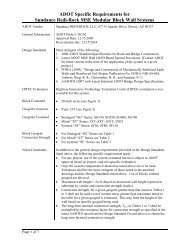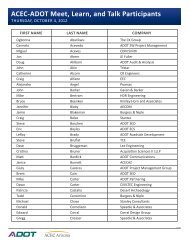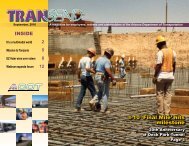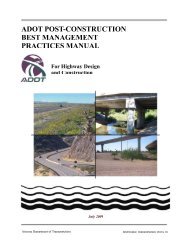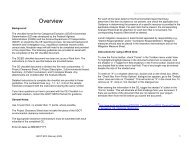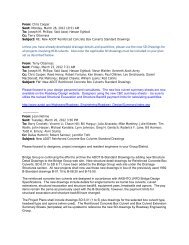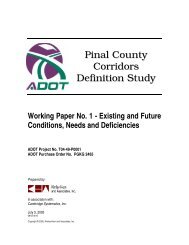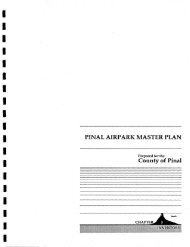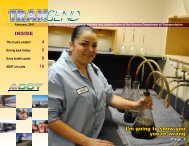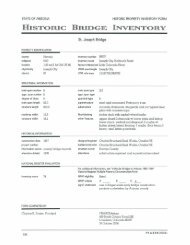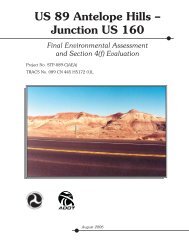I-10 Twin Peaks Traffic Interchange, Environmental Assessment
I-10 Twin Peaks Traffic Interchange, Environmental Assessment
I-10 Twin Peaks Traffic Interchange, Environmental Assessment
Create successful ePaper yourself
Turn your PDF publications into a flip-book with our unique Google optimized e-Paper software.
Affected Environment and <strong>Environmental</strong> Impacts October 2005<br />
Desertscrub vegetation is found in the light industrial area west of I-<strong>10</strong> to the Santa<br />
Cruz River and east of I-<strong>10</strong> to Linda Vista Boulevard.<br />
Riparian Scrub is associated with dry ephemeral washes that occur throughout the<br />
study area, but occur in the highest density and most natural condition east of El<br />
Camino de Mañana along Linda Vista Boulevard. Riparian Scrub vegetation is<br />
characterized by plant species found in adjacent desertscrub habitat, such as<br />
foothill palo verde and velvet mesquite, although riparian plants are typically<br />
larger and often occur at higher densities than those in upland areas. Plants in this<br />
association grow in rows along the margins of the watercourses and are clearly set<br />
apart from the intervening vegetation of the uplands. Plant species present include<br />
foothills paloverde and velvet mesquite. Most of the washes have been stabilized<br />
within Continental Ranch and within the residential housing areas along Linda<br />
Vista Boulevard. Stabilized washes in these areas have straightened stream<br />
channels, improved bank protection (often using soil cement), and are cleared of<br />
most vegetation.<br />
Cottonwood/Willow Riparian Forest occurs along the Santa Cruz River. This<br />
vegetation association is characterized by a narrow band of small to moderatesized<br />
(<strong>10</strong> to 30 feet in height) Freemont cottonwood and Goodding willow.<br />
Additional plant species in the area include seep willow, cattail, bulrush, tamarisk,<br />
and velvet mesquite. Along this reach of the Santa Cruz River, Riparian Forest is<br />
restricted to small, scattered stands separated by areas of low shrubs such as<br />
desertbroom and seep willow. The Riparian Forest is restricted to the low-flow<br />
channel where the influence of perennial effluent water flow from Pima County's<br />
Roger and Ina Road Treatment Plants allows this vegetation to survive in an<br />
otherwise dry river. Vegetation outside the low-flow channel, in the high-flow<br />
channel, is characteristic of disturbed areas. This vegetation consists of<br />
desertbroom, shrub-like velvet mesquite, four-wing saltbush, and grasses. In<br />
addition, large areas of bare soil characterize the high-flow channel.<br />
Riparian habitat includes the trees, other vegetation, and physical features<br />
normally found on the banks and floodplains of rivers, streams, and other bodies of<br />
water. Although riparian areas occupy a small area, they support a diversity of fish<br />
and wildlife species. In addition, riparian areas can help reduce flood flows and<br />
flood damage, improve groundwater recharge, reduce the damaging chemicals and<br />
other compounds that reach open water, and reduce wind erosion on adjacent<br />
lands. Riparian areas also provide important open space and recreational<br />
opportunities. Riparian areas approximate the jurisdictional waters presented in<br />
Figure 4-3.<br />
Wetlands are low-lying areas typically saturated with moisture that typically<br />
provide habitat for a variety of plant and animal species, including many<br />
endangered species. The state of Arizona has no wetland protection program, but<br />
wetlands are regulated by the Corps under Section 404 of the CWA. A regulated<br />
wetland is one that meets 3 criteria: 1) hydrophytic vegetation; 2) hydric soils; and,<br />
3) wetland hydrology (the presence of water).<br />
Interstate <strong>10</strong> <strong>Traffic</strong> <strong>Interchange</strong> at<br />
<strong>Twin</strong> <strong>Peaks</strong>/Linda Vista<br />
4-37<br />
Project No.: NH-0<strong>10</strong>-D (AIW)<br />
TRACS No.: <strong>10</strong> PM 236 H5838 01D



